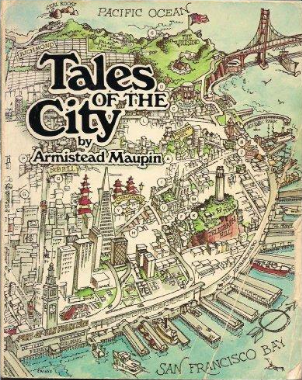The roots of Maupin's Tales column started in the San Francisco Chronicle after he attempted to write a 1976 article about the Marina Safeway. It was, at the time, a well-known pick-up joint every Wednesday night, but when Maupin failed to find any singles willing to talk honestly about what they were doing at the supermarket, he decided to transform the story into fiction. Maupin quickly made a deal with his editors that allowed him to write about gay characters too; they said as long as the gay characters only made up a third of the cast, it was okay. The community was impossible to keep out. As Maupin himself wrote: “In this town, the love that dare not speak its name never shuts up.”
Maupin Loved San Francisco Before He Even Lived In It
 Originally hailing from Raleigh, North Carolina, the author's father was a Confederate flag-owning segregation supporter. Maupin did two tours of duty in the Navy, the bulk of which was spent working as a communications officer in Vietnam. (He returned there to build houses for disabled veterans after the war. ) The process of leaving the Navy in 1970 required Maupin to go to Treasure Island. “I stood there and looked at the city," he recalled. "That extraordinary white vision rising above the blue water... [I] used to fantasize about living there… It wasn’t until several years later that I realized the dream could come true.”
Originally hailing from Raleigh, North Carolina, the author's father was a Confederate flag-owning segregation supporter. Maupin did two tours of duty in the Navy, the bulk of which was spent working as a communications officer in Vietnam. (He returned there to build houses for disabled veterans after the war. ) The process of leaving the Navy in 1970 required Maupin to go to Treasure Island. “I stood there and looked at the city," he recalled. "That extraordinary white vision rising above the blue water... [I] used to fantasize about living there… It wasn’t until several years later that I realized the dream could come true.”
Tales Helped People Come Out
The beautiful coming out letter that Michael wrote to his Anita Bryant-supporting parents in the original Tales of the City book is based on Maupin’s own to his conservative parents. Others, including a caller to KQED's Forum last April, have since used it as a blueprint to come out to their own families. It reads in part:
"If you and Papa are responsible for the way I am, then I thank you with all my heart, for it's the light and the joy of my life... Being gay has taught me tolerance, compassion and humility. It has shown me the limitless possibilities of living. It has given me people whose passion and kindness and sensitivity have provided a constant source of strength. It has brought me into the family of man, Mama, and I like it here. I like it."
It Was A Major Step Forward For Trans Visibility
Though Maupin was permitted to introduce gay characters six weeks into writing his column, he was firmly prohibited from revealing Anna Madrigal's trans status for an entire year, "or else we'd scare off the readers." That delay mattered little in the grand scheme of things. In a 1992 BBC Arena documentary, Kate Bornstein, a transgender woman living in San Francisco, expressed how much Tales meant to her growing up, saying, “I thought, if a city can accept a transexual character drawn with so much love, there is some hope.”
Maupin, executive producer of the new show, has said that a real trans woman would have been cast in the role of Anna Madrigal if it were being cast for the first time now. “When Olympia did [it] in 1992, no one else would touch it," Laura Linney confirmed on Forum. "And what she was able to do for the trans community then is something that had not been done before.”
28 Barbary Lane is Still in Russian Hill
Though 28 Barbary Lane is a fictitious address, it's based on the real-life Macondray Lane in Russian Hill, described in 1978's Tales Of The City thusly:
"The house was on Barbary Lane, a narrow, wooded walk-way off Leavenworth between Union and Filbert. It was a well-weathered, three-story structure made of brown shingles. It made Mary Ann think of an old bear with bits of foliage caught in its fur. She liked it instantly."
The First Tales TV Adaptation Is Now 26 Years Old
Just as SF residents are prone to revisiting Maupin's Tales books, Laura Linney and Olivia Dukakis have been doing the same thing with their roles as Mary Ann Singleton and Anna Madrigal respectively, since 1993. At the time of that first adaptation—which also starred a gloriously freewheeling Parker Posey—the series had PBS's highest ever ratings for a drama. It also had the distinction of being one of the first positive portrayals of the LGBTQ community in TV history.
Linney and Dukakis reprised their roles on Showtime in 1998 and 2001. Back in April, Laura Linney told Forum: “There was something about walking back on that set again. Being able to step back into that world, into that house… It goes deep for me now… It means something to me, not just my character now.”
The New Series Seems To Be Based On 2010's Mary Ann in Autumn
The darkest of the Tales books, 1989's Sure of You saw Mary Ann leaving San Francisco, her husband and her adopted daughter, Shawna, to pursue a prestigious TV job in New York. In 2010's Mary Ann In Autumn, she returns to the city in ill-health, reconnecting with the loved ones of her past, including her estranged daughter, who is now a popular sex blogger. Though the Netflix adaptation isn't sticking with the plot exactly—in the book, Shawna was dating a professional clown named Otto; in the series, played by Ellen Page, she is involved with a woman named Claire (Zosia Mamet)—the bare bones probably remain similar. “We’ve hired queer writers to write the story," Maupin told Forum, "and they’ve shared their experiences.”

 Originally hailing from Raleigh, North Carolina, the author's father was a Confederate flag-owning segregation supporter. Maupin did two tours of duty in the Navy, the bulk of which was spent working as a communications officer in Vietnam. (He returned there to build houses for disabled veterans after the war. ) The process of leaving the Navy in 1970 required Maupin to go to Treasure Island. “I stood there and looked at the city," he recalled. "That extraordinary white vision rising above the blue water... [I] used to fantasize about living there… It wasn’t until several years later that I realized the dream could come true.”
Originally hailing from Raleigh, North Carolina, the author's father was a Confederate flag-owning segregation supporter. Maupin did two tours of duty in the Navy, the bulk of which was spent working as a communications officer in Vietnam. (He returned there to build houses for disabled veterans after the war. ) The process of leaving the Navy in 1970 required Maupin to go to Treasure Island. “I stood there and looked at the city," he recalled. "That extraordinary white vision rising above the blue water... [I] used to fantasize about living there… It wasn’t until several years later that I realized the dream could come true.”
